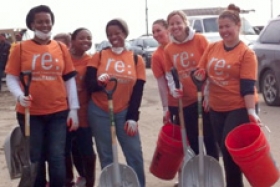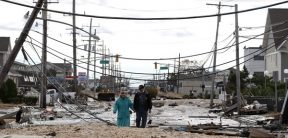You are here
Six Months Later

HEFN Communications Associate Lauren Linville authored this blog post.
It seems much longer than six months ago that Hurricane Sandy turned into Superstorm Sandy and devastated parts of New York and New Jersey. In the aftermath of the storm, philanthropy responded with millions of dollars for relief, recovery, and rebuilding.
Not surprisingly, funders based in New Jersey and New York have invested heavily in these efforts. The Geraldine R. Dodge Foundation in partnership with the Community Foundation of New Jersey quickly established a New Jersey Recovery Fund to address intermediate and long-range impacts from Sandy (See Margaret Waldock of the Dodge Foundation’s guest post). Within two weeks of the storm, the New York Community Trust made $500,000 in grants to disaster relief and has made $965,000 in grants since then for ongoing recovery and resiliency planning.
As philanthropy looks back at the last six months, and forward to what’s next for impacted communities, NGOs and experts have been sharing their lessons learned from Sandy. Here are some highlights of challenges, opportunities, and advice offered by groups in the field on recent calls hosted by the Center for Disaster Philanthropy and the Council of New Jersey Grantmakers.
Challenges
Mold. Public officials have warned that mold in houses flooded by Sandy’s storm surge is a growing threat to public health, especially as temperatures rise this spring. The National Institute of Environmental Health Sciences (NIEHS) has provided advanced training for responders and is working with the Occupational Safety and Health Administration to evaluate exposure patterns since the storm. However, groups like the New Jersey Work Environment Council have requested funding for additional intensive trainings from the NIEHS for volunteers, workers, and homeowners.
Toxic exposures. Residents near some of New Jersey’s most contaminated places have expressed concern about toxic chemicals in storm water that flooded homes and parks. In Newark’s Ironbound neighborhood, community members worry that flood water laced with toxic sediment from the Passaic River Superfund site and chemicals from industrial zones could pose long-term health hazards. The U.S. Environmental Protection Agency (EPA) tested soil in Riverside Park, next to the Passaic River, for dioxin, mercury and PCBs. The agency concluded the soil had been contaminated during flooding, but that levels were not high enough to be considered a public health threat. The EPA plans to move forward with the Superfund site cleanup in beginning July 1, yet residents are concerned the plan will not prevent future contamination.
Permit waivers. Environmental and public health advocates in New Jersey are raising red flags about changes to the state’s permitting process. A new waiver allows homeowners and business owners planning to rebuild on waterfront or shoreline properties to skip a step of the permitting process requiring plan approval by state regulators. Opponents say the ruling reduces oversight and encourages development in flood- and storm surge-prone areas.
Flood maps and buyouts. For some homeowners and businesses, recovery and rebuilding have been put on hold as policymakers evaluate plans for updated flood maps and buyouts. New Federal Emergency Management Agency (FEMA) flood maps, which hadn’t been updated since the 1980s, will be used to set flood insurance requirements that will likely mean many homes in New Jersey will have to be elevated, with costs depending on the zone in which the house is located. Some residents have suspended rebuilding efforts until the new maps are finalized. Others are lobbying FEMA to re-zone their properties to avoid costly elevation projects. Conversely, New York Governor Cuomo is offering incentives for homeowners to accept buyout offers from the state rather than wait for revised flood maps or insurance claims. In New Jersey, homeowners are still waiting for more details about buyout offers.
Opportunities
Strengthening overburdened populations. Many families on the road to recovery were some of the most overburdened populations before the storm. As funders help communities rebuild, Ana Baptista of the Ironbound Community Corporation in Newark notes it’s important to not exacerbate existing vulnerabilities. In the short-term, Ironbound and community groups are helping impacted residents get back on their feet with case management support to help families apply for FEMA assistance, weigh buyout options, and process insurance claims. Over the long-term, NGOs are advocating for these communities to be included in crafting climate change adaptation plans.
Convening and research. Ronna Brown, President of Philanthropy NY, and Nina Stack, President of the Council of New Jersey Grantmakers, agree that the philanthropic and NGO communities could play a key role in conversations around rebuilding. Brown suggested funders could act either as the convener or as a supporter of a convening, and she reported that some funders are supporting research into innovative ways to support communities in recovery and rebuilding.
Advice
Resist urge to get money out the door as quickly as possible. After a disaster there is usually an influx of funding and support that floods into foundations and organizations. Some groups working with Sandy funders are advising groups to think strategically about timing their support as recovery and rebuilding efforts may take years. They encourage foundations to take a measured approach to post-disaster giving to better identify gaps in support that might otherwise have gone unnoticed or addressed.
Invest in communication infrastructure. Funder affinity groups in New York and New Jersey cite existing regional networks of NGOs and foundations as key to communicating in the storm’s aftermath. They credit this type of infrastructure with making it possible for funders to set up conference calls quickly to coordinate relief efforts and share information. Groups also advise funders and NGOs to build connections with community members before a natural disaster or event happens.
Discuss disaster planning with your board. Does your board know what it would do if your community or region was struck by tragedy? Groups suggest funders discuss with their boards about disaster planning and response. Some questions they suggest for board consideration are: How would the foundation respond operationally? At what level (geographically and financially) would the foundation support relief efforts? What will happen to groups the foundation has supported for a long time, especially if they are not involved in disaster-related work? Funder affinity groups have also recommended that foundations not plan too much in advance of a disaster as conditions and needs evolve quickly.
From our Blog
Upcoming Events
|
Apr 23 2024 Zoom |
Apr 30 2024 Zoom |

